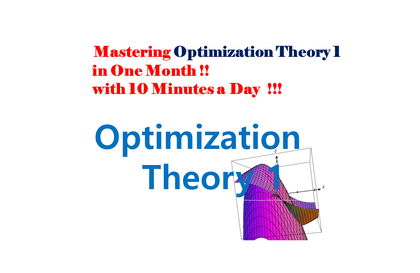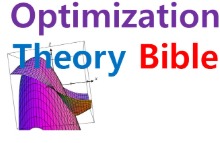
하루 10분 한달완성 최적화이론 1
임장환
AI/딥러닝, 컴퓨터 비젼, 컴퓨터 그래픽 등에 필요한 최적화이론 입니다. 최적화이론1에서는 중점적으로 다변수함수의 정의와 다변수함수의 미분을 다루고 있습니다. 왜 그럴까요! 모든 최적화 문제는 다변수 함수 형태로 표현되기 때문입니다. 정확한 다변수 함수의 정의와 미분개념을 습득하시면 위 분야의 이론적 접근이 상당히 쉬워집니다.
初級
최적화이론, 선형대수학, 머신러닝
The core of all AI/deep learning is ultimately optimization. Of course, optimization theory is not only needed in AI/deep learning. Computer vision, robotics & control systems, financial engineering & quant, data science, signal processing... Probably no matter which field you study, optimization theory is one of the topics you will inevitably encounter when you go deeper. This lecture systematically covers everything from basic mathematical theory to in-depth content. I believe it is by far the best optimization theory lecture offered in Korea.

A very detailed explanation of the theory of Taylor series expansion for multivariable functions The Taylor series expansion for multivariable functions is a fundamental concept in multivariable calculus that extends the single-variable Taylor series to functions of multiple variables. This theory provides a powerful tool for approximating complex multivariable functions using polynomial expressions. **1. Foundation and Motivation** For a single-variable function f(x), the Taylor series around point a is: f(x) = f(a) + f'(a)(x-a) + f''(a)(x-a)²/2! + f'''(a)(x-a)³/3!
Explanation from the Definition of Convex Functions to Core Theory ## Definition of Convex Functions A function f: ℝⁿ → ℝ is called **convex** if its domain is a convex set and for all x, y in the domain and λ ∈ [0,1], the following inequality holds: f(λx + (1-λ)y) ≤ λf(x) + (1-λ)f(y) This means that the function value at any point on the line segment connecting two points is always less than or equal to the linear interpolation of the function values at those two points. ## Geometric
A Very Detailed Explanation of Gradient Descent Search Method Gradient Descent is one of the most fundamental optimization algorithms in machine learning and deep learning. It's a method for finding the minimum value of a function by iteratively moving in the direction of the steepest descent. ## Basic Concept Imagine you're standing on a mountainside in thick fog and want to reach the bottom of the valley. You can't see the entire landscape, but you can feel the slope beneath your feet. Gradient descent works similarly - it
Explanation of Backpropagation Algorithm Using Gradient Descent Method
A detailed explanation of Newton's method as an alternative to Gradient Descent Newton's method is an optimization algorithm that can serve as an alternative to gradient descent for finding the minimum of a function. Here's a comprehensive explanation: ## Basic Concept While gradient descent uses only first-order derivatives (gradients), Newton's method utilizes both first-order derivatives (gradients) and second-order derivatives (Hessian matrix) to find the optimal solution more efficiently. ## Mathematical Foundation For a function f(x), Newton's method update rule is: **x_{k+1} = x_k - H^{-1}(x_k) ∇f
Explanation of the Levenberg-Marquardt Type Damped Newton Method, which combines Gradient Descent and Newton search methods The Levenberg-Marquardt method is a hybrid optimization algorithm that combines the advantages of both Gradient Descent and Newton's method. This approach addresses the limitations of each individual method by adaptively switching between them based on the optimization progress. **Key Components:** 1. **Gradient Descent Component:** - Provides stable convergence even when far from the optimum - Uses first-order derivative information - Guaranteed to move in the descent direction - Slower convergence rate but more robust 2. **Newton Method Component:** - Utilizes second-order derivative information (Hessian matrix) - Provides quadratic convergence near the optimum - Faster convergence when close to the solution - Can be unstable when far from the optimum **Damping Mechanism:** The method introduces a damping parameter (λ)
Introduction to Quasi-Newton Method
Detailed Explanation of the Levenberg-Marquardt Method, a Nonlinear Least Squares Approach The Levenberg-Marquardt (LM) method is a powerful optimization algorithm used to solve nonlinear least squares problems. It combines the advantages of the Gauss-Newton method and the gradient descent method, making it particularly effective for curve fitting and parameter estimation problems. ## Problem Definition The nonlinear least squares problem aims to minimize the sum of squared residuals: minimize: S(β) = Σᵢ₌₁ᵐ [yᵢ - f(xᵢ, β
Lagrange multiplier method
The Lagrange multiplier method with both equality and inequality constraints is a comprehensive optimization technique that extends the basic Lagrange method to handle more complex constrained optimization problems. ## Basic Lagrange Multiplier Method (Equality Constraints Only) For a problem with only equality constraints: - Objective function: minimize f(x) - Equality constraints: g_i(x) = 0, i = 1, 2, ..., m The Lagrangian function is: L(x, λ) = f(x) + Σ λ_i g_i(x) The necessary conditions (KKT conditions for equality constraints) are: 1. ∇_x L = ∇f(x) + Σ λ_i ∇g_i(x) = 0 2. g_i(x) = 0 for all i ## Karush-Kuhn-Tucker (KKT) Method (Equality and Inequality Constraints
The KKT Conditions (Karush-Kuhn-Tucker Conditions) are fundamental optimality conditions for constrained optimization problems. Let me explain them in great detail. ## 1. Background and Purpose The KKT conditions extend the method of Lagrange multipliers to handle inequality constraints in addition to equality constraints. They provide necessary conditions for optimality in nonlinear programming problems and, under certain regularity conditions, also sufficient conditions. ## 2. Problem Formulation Consider the general constrained optimization problem: **Minimize:** f(x) **Subject to:** - g_i(x) ≤
Theoretical Explanation of SVM (Support Vector Machine) Using KKT Conditions Support Vector Machine (SVM) is a powerful machine learning algorithm that finds the optimal hyperplane to separate different classes of data. The theoretical foundation of SVM is deeply rooted in the Karush-Kuhn-Tucker (KKT) conditions, which provide the mathematical framework for solving the constrained optimization problem that SVM represents. ## SVM Optimization Problem SVM aims to find the hyperplane that maximizes the margin between different classes. This can be formulated as a constrained optimization problem: **Minimize:** ½||w||² + C∑
Who is this course right for?
For those who want to deeply study artificial intelligence in the AI era "Highly Recommended"
For those studying engineering, especially computer vision and robotics, "highly recommended"
For those studying statistics and economics who want to study optimization theory in depth, "highly recommended"
Need to know before starting?
Linear Algebra, Calculus
207
Learners
8
Reviews
7
Answers
4.8
Rating
4
Courses
박사 졸업 후 5년 정도 Computer vision를 공부하고 가르치는 계기가 돼서
지금까지 수학전공과 공학이론을 연결한 공부들을 하고 있습니다.
전문분야(공부 분야)
전공: 수학(Topological Geometry), 부전공(컴퓨터 공학)
현) 3D Computer Vision(3D Reconstruction) , Kalman Filter, Lie-group(SO(3)),
Stochastic Differential Equation 연구자
현) 유튜브 채널 운영: 임장환: 3D Computer Vision
현) facebook Spatial AI KR 그룹 (수학전문위원)
출신학교
독일 Kile 대학 이학박사 (Topological Geometry & Lie-group 전공, 컴퓨터 공학 부전공)
중앙대 수학과 학사, 석사(Topology 전공)
경력
전) 대성그룹 자회사 두비비젼 CTO
전) 중앙대학교 첨단영상 대학원 연구교수(3D Computer Vsion연구)
저서:
최적화이론: https://product.kyobobook.co.kr/detail/S000200518524
링크
유튜브: https://www.youtube.com/@3dcomputervision
블로그: https://blog.naver.com/jang_hwan_im
All
31 lectures ∙ (6hr 56min)
Course Materials:
$89.10
Check out other courses by the instructor!
Explore other courses in the same field!